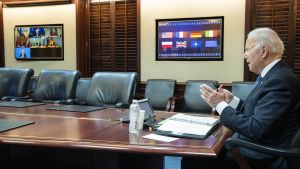Explainer: Eastern Europeans Split over Russia's War in Ukraine

Recent polls find a geographic divide in the region when it comes to public perceptions of the conflict.
Since the beginning of the war in Ukraine, Western countries have condemned Russian aggression by levying sanctions against Moscow and supporting Kyiv with machinery and weapons. Despite this unified front Western countries are presenting at the policymaking level, publics in various European countries display differing appetites for aiding Ukraine and punishing Russia. Nowhere are these differences more pronounced than in Eastern Europe, where national safety considerations, economic interests, and historical narratives come together to define a complex relationship with Russia.
Polls such as the Eurobarometer and GLOBSEC conducted between March and July 2022 show that there is a geographic divide within Eastern Europe when it comes to the public's perception of the war and Russia. Northern countries in Eastern Europe, namely Estonia, Latvia, Lithuania, Poland, and the Czech Republic, tend to support Ukraine and to support imposing harsh sanctions on Russia. On the other hand, southeastern European publics in countries like Slovakia, Hungary, Romania, and Bulgaria consistently display more pro-Russian sentiments and are more hesitant to sign on to policies that directly confront President Vladimir Putin’s government. The degree of division between the two differs somewhat from issue to issue but proves significant when it comes to NATO, Russia's perceived threat, and the war itself.
Northeastern Europe Strongly Backs Sanctions
The “Summer 2022 Standard Eurobarometer” was conducted across the 27 European Union member states between June 17 and July 17. The data show while majorities of the public across Eastern Europe support imposing sanctions on Russia, the degree of support varies widely, with northern publics much more united in their support for sanctions than southern ones. Poland and Bulgaria represent the two ends of the spectrum, with 93 percent and 46 percent of their respective publics expressing support for sanctions on Russia. Sanctions are a powerful tool designed to make continuing the war economically painful for the Russian leadership but might be seen as less of direct opposition to Russia than something like sending troops or weapons to Ukraine. This may help explain why differences in public opinion on sanctions are not as pronounced as on some other policies.
A North-South Split in Support for Aid to Ukraine
Indeed, the distinction also appears in the Eurobarometer when these same countries are asked about the extent to which they would support financially supplying and delivering military equipment to Ukraine. The difference in commitment is vast, with 91 percent of Poles in favor compared to 61 percent of Romanians. This pattern is consistent with a North-South divide as an overwhelming majority (91 to 75%) of Northern countries support a more involved role, with the only exception of the Czech Republic, where 56 percent of people are in favor. In southeastern European countries, the percentage of people that agree with financial and military assistance is between 61 and 38 percent.
Northern Nations More Likely to View Russia as a Threat
Part of the reason that the northern countries of Eastern Europe are more willing to support Ukraine or punish Russia may be because, according to a March 2022 GLOBSEC poll, they perceive Russia as more of a threat than their neighbors to the south do. An average of 78 percent of the public in the five northeastern European countries believe Russia poses a security threat to their country, with Poland (90%) feeling the most threatened by Russia. In contrast, an average of 50 percent of the public in the four southeastern European countries said the same about Russia, with Bulgarians feeling the least threatened (33%).
This is not to say that the southern countries are unconcerned about Russia in the aftermath of the invasion of Ukraine. Majorities in Slovakia (62%) and Romania (58%) view Russia as a threat, and these numbers have risen dramatically since 2020 when just 20 percent of Slovaks and 30 percent of Romanians said the same. But southern publics are consistently less likely than northern publics to view Russia as a threat. Latvians are the northeastern public that is least likely to view Russia as a threat (64%), largely due to the large share of the Latvian population that is ethnically Russian. And yet they are more concerned about the threat Russia poses than any of their southeastern counterparts.
Historical Relations with Russia
History is a key factor that influences each Eastern European country's view of Russia as a threat and their willingness to sign on to counter Russia actions following the invasion of Ukraine. The Baltic states, for example, were annexed by the Kremlin in 1940 and remained under Soviet rule for nearly 50 years—all this after only gaining independence in the first place at the end of World War I. This history makes some of the Kremlin's justifications for the invasion of Ukraine, particularly that it is an "artificial state with no history," extremely concerning to those in the Baltic states, who fear that Russia could make the same false claims about their own countries. The Polish people also have a long history of having to fight for their borders and independence, often against Russia or the Soviet Union. Soviet massacres of Poles leading up to and during World War II also feature heavily in the country's collective memory.
The past also likely plays a role in the views of the public in the southern European countries. While many of these countries also have a history of fighting with or occupation by Russia, a number have maintained closer political and economic ties with Moscow in recent years. For Bulgarians, Russia's involvement in their late nineteenth-century struggle for independence has contributed to an image of Russia as a savior and liberator—a narrative that is reinforced today through textbooks, monuments, and holidays. Bulgarians and Russians also share linguistic, religious, and cultural roots. Hungary, meanwhile, chafed under Soviet military occupation during the Cold War. But in recent years, Prime Minister Viktor Orban has championed pro-Russia policy within the European Union and intentionally deepened his country's energy ties with Russia. In Slovakia, some segments of the public are more pro-Russia due to ideas of a shared Slavic identity and push back on Western liberal influences in the country. Finally, Romania followed the Soviet domestic model fairly closely in the late 20th century by outlawing property ownership, religion, and more, which created some societal bonds and similarities that could impact views today, especially among those old enough to remember this period.
While each Eastern European country's historic and current relationship with Russia is unique, these historic interactions, cultural similarities, and the national narratives they have helped foster can help explain the public's policy preferences in the context of the war in Ukraine.
Role of Disinformation Campaigns
Finally, public opinion about Russia in Eastern Europe cannot be discussed without mentioning the role of disinformation campaigns in the region. Spreading misinformation to shape countries’ perception and attitudes toward Russia is a favored foreign policy tool of the Kremlin.
Russia pays journalists in Eastern European countries to exploit and twist domestic debates over westernization, the United States, and NATO. Bulgaria, for example, has been targeted heavily by Russian disinformation campaigns. Disinformation has penetrated the media landscape there so deeply that the Bulgarian tabloid Trud translated and reprinted an article equating Ukrainian soldiers to Nazis. This article became a sensation and stoked a national debate giving Russian supporters a platform. In this way, disinformation highlights pro-Russian narratives and tries to disrepute Western media sources.
Some evidence suggests that southern countries in Eastern Europe may be particularly vulnerable to Russian disinformation. A poll by GLOBSEC ran an experiment to measure susceptibility to disinformation across Eastern European publics. The experiment measured the average belief in three commonly promoted conspiracy theories about democracy and international order and found that the average level of belief in these conspiracy theories is higher in southern Eastern European countries than in northern ones. In the southern countries, between 41 percent and 54 percent of people believe in conspiracies on average, whereas the number in Northern ones is between 30 percent and 39 percent. These data indicate that higher susceptibility to anti-democracy disinformation could be a factor in the lower willingness of southern countries in Eastern Europe to support Ukraine and punish Russia.
Conclusion
There is a range of factors, such as the perceived threat from Russia, common history, and disinformation, that shape the different ways Eastern European countries view the war in Ukraine. Together, these factors divide the North and South of the region. Yet with the rising prices of gas this winter, these divisions might shift. Up until this point, the governments of the Czech Republic, Poland, and the Baltic States have been steadfast in supporting Ukraine and imposing consequences on Russia, but significant changes in public opinion could pressure changes in course on policy. For example, at the beginning of September, over 70,000 protesters in the Czech Republic gathered to call for an end to sanctions in Russia—just one example of how looming colder temperatures, energy crises, and economic woes could significantly impact opinion in the coming months.




Related Content
 Public Opinion
Public Opinion
Public support for US military bases on the continent is also on the rise, Council polling reveals.
 Public Opinion
Public Opinion
And bipartisan majorities of Americans support admitting new members to the alliance, Council polling shows.
 Global Politics
Global Politics
"If Russia’s struggles in Ukraine herald its broader decline, it’s unlikely an easy peace is ahead for many in Russia’s neighborhood," Elizabeth Shackelford writes.
